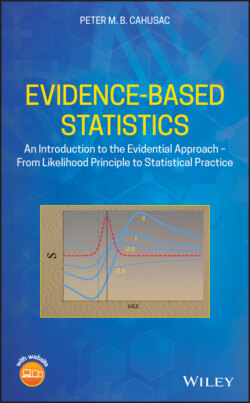Читать книгу Evidence-Based Statistics - Peter M. B. Cahusac - Страница 20
1.2.4 Pros and Cons of Likelihood Approach Advantages:
Оглавление1 Provides an objective measure of evidence between competing hypotheses, unaffected by the intentions of the investigator.
2 Calculations tend to be simpler, and are often based on commonly used statistics such as z, t, and F.
3 Likelihoods, LRs and support (log LR) can be calculated directly from the data. Statistical tables and critical values are not required.
4 The scale for support values is intuitively easy to understand ranging from −∞ to +∞. Positive values represent support for primary hypothesis, negative values represent support for secondary hypothesis.3 Zero represents no evidence for either hypothesis.
5 Support values are proportional to the quantity of data, representing the weight of evidence. This means that support values from independent studies can simply be added together.
6 Collecting additional data in a study will tend to strengthen the support for the hypothesis closest to the true value. By contrast with p values, even when the null hypothesis is true, additional data will always eventually give statistically significant results, to any level of α (0.05, 0.01, 0.001, etc.) required.
7 Categorical data analyses are not restricted by normality assumptions, and within a given model, support values sum algebraically.
8 It is versatile and has unlimited flexibility for model comparisons.
9 The stronger the evidence the less likely it is to be misleading because S has a universal bound of e−m of observing misleading evidence, where m is the support for any two hypotheses.
10 Unlike other approaches based on probabilities, it is unaffected by transformations of variables.
